 W
WAbout 25,000 inscriptions found in Karnataka belongs to Kannada rulers like Kadambas, Western Ganga Dynasty, Rashtrakuta, Chalukya, Hoysala and Vijayanagara Empire. Many inscriptions related to Buddhism and Jainism are unearthed. The inscriptions generally found are on stone (Shilashasana) or copper plates (Tamarashasana). The Kannada inscriptions found on historical Hero Stone, coin and temple wall, piller, tablet and rock edict. These Inscription have contributed towards Kannada literature and helped to classify as Proto Kannada, Pre Old Kannada, Old Kannada, Middle Kannada and New KannadaInscriptions depicts culture, tradition and prosperity of those era. The world wide recognized literature Ramayana and Mahabharata are transferred through generation by these Inscription Hazara Rama Temple and Aranmula Parthasarathy Temple are the best example.
 W
WKannada literature is the corpus of written forms of the Kannada language, a member of the Dravidian family spoken mainly in the Indian state of Karnataka and written in the Kannada script.
 W
WĀdi purāṇa is a 9th century Sanskrit poem composed by Jinasena, a Digambara monk. It deals with the life of Rishabhanatha, the first Tirthankara.
 W
WThe Atakur inscription dated 949-950 C.E. is an inscribed memorial stone with classical Kannada composition inscription. It was discovered at the Chelleshvara temple at Atakur village about 23 km from Mandya city in the Karnataka state, India. The "motion packed" sculptured hero stone describes two events in poetic Kannada; the battle between "Kali" the hound and a wild boar, and the victory of Rashtrakuta Emperor Krishna III over the Chola dynasty of Tanjore in the famous battle of Takkolam. According to historians I. K. Sarma and Singh memorial stones for warriors are common in medieval India, but one erected in memory of an animal is considered unique.
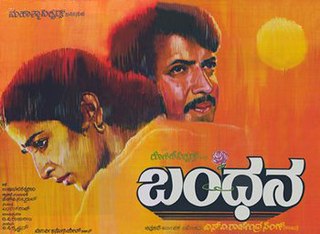 W
WBandhana is a 1984 Indian Kannada-language romantic drama film directed by Rajendra Singh Babu, based on a novel by Usha Navaratnanram of the same name, and starring Vishnuvardhan and Suhasini.
 W
WThe Basava Purana is a 13th-century Telugu epic poem. It was written by Palkuriki Somanatha. It is a sacred text of Lingayat. The epic poem narrates the life story of philosopher and social reformer Basava, the founder of Lingayat. He is also known by several other names such as Basavanna, Basaweshwara, Basavesha, and Basavaraja. It is also an anthology of several Lingayat saints and their philosophies. In contrast to campu style, Somanatha adopted the desi (native) style and composed the purana in dwipada (couplets), a meter popular in oral tradition and closely related to folk songs.
 W
WBelli Moda is a 1967 Kannada-language film directed by Puttanna Kanagal. It was based on the novel of same name by Triveni.
 W
WBettada Jeeva is a National Award-winning (2011) Kannada film directed by P. Sheshadri starring Suchendra Prasad, Rameshwari Varma and H. G. Dattatreya. The story is based on Jnanpith awardee K. Shivaram Karanth's novel. It depicts the tradition of people living in remote areas of Western Ghats during pre-Independence days in India.
 W
WChandavalliya Thota is a 1964 Indian Kannada language film, directed by T. V. Singh Thakur It stars Rajkumar, Udaykumar and Jayanthi in the lead roles. The film won many laurels upon release including the National Film Award for Best Feature Film in Kannada for its Gandhian theme treatment of the poverty in rural Indian villages. The movie is based on the novel of same name by Ta.Ra.Su.
 W
WChikavira Rajendra or Chikka Vira Rajendra, was the last ruler of the Kodagu (Coorg) kingdom in South India. His actual name was Vira Rajendra, but this was the name of his uncle as well; as both of them were rulers of Kodagu, the prefix Chikka is used as a distinguisher. He was a son of Linga Rajendra II.
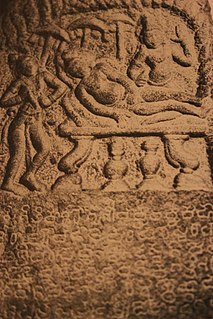 W
WThe Doddahundi nishidhi and inscription is a hero stone from Doddahundi, 18 km from Tirumakudalu Narasipura in the Mysore district, Karnataka state, India. It has an undated old Kannada language inscription which historians J. F. Fleet, I. K. Sarma and E.P. Rice have dated by context to 840 or 869 C.E. The hero stone has a unique depiction in frieze of the ritual death of the Western Ganga Dynasty king Ereganga Nitimarga I. The memorial was raised by the king's son Satyavakya. Such nishidhi's were raised in medieval India in honor of important Jain personalities who ended their life voluntarily after following severe ritual vow. The Western Ganga period produced not only imposing and well sculptured pillars (stambha) but also noteworthy hero stones (virgal) with exceptional relief. According to historian and epigraphist J. F. Fleet who edited the inscription, the names in the record are titles and not personal names. He dated the inscription to 840 C.E. with the opinion that the Nitimarga in the inscription is actually Ranavikrama, son of King Sripurusha.
 W
WDweepa is a 2002 Indian Kannada-language film by Girish Kasaravalli, based on the novel of the same name by Na D'Souza, and starring Soundarya and Avinash. Dweepa deals with the raging issue of building dams and the displacement of natives. It won two National Film Awards, four Karnataka State Film Awards and three Filmfare Awards South.
 W
WGejje Pooje is a 1969 Indian Kannada language film directed by Puttanna Kanagal and produced by Rashi Brothers. The film stars Kalpana, Gangadhar and Leelavathi in the lead roles. Gejje means anklet and pooje means worship, but in the context of this film, it means a mock marriage. The film is based on the novel Gejje Pooje, by M. K. Indira. The film was remade in Tamil as Thaaliya Salangaiya, in Telugu as Kalyana Mandapam and in Hindi as Ahista Ahista, which further inspired the 2007 Hindi movie Laaga Chunari Mein Daag.
 W
WGhatashraddha is a 1977 Indian Kannada language film directed by Girish Kasaravalli starring Meena Kuttappa, Narayana Bhat and Ajith Kumar in lead roles. It is based on a novella by eminent Kannada writer U. R. Ananthamurthy. The film was Girish Kasaravalli's first feature film as a director, and marked not only the arrival of a promising new filmmaker but also that of Kannada cinema in the India's 'New Cinema' horizon.
 W
WThe Halmidi inscription is the oldest known Kannada language inscription in the Kadamba script. While estimates vary slightly, the inscription is often dated to between 450 CE - 500 CE. The inscription was discovered in 1936 by Dr. M. H. Krishna, the Director of Archaeology of the (princely) State of Mysore, in Halmidi, a village in the Hassan district.
 W
WHamsageethe is a 1975 Indian feature film in the Kannada language. It was directed by G. V. Iyer, based on a novel by T. R. Subba Rao with Anant Nag and Rekha Rao in lead roles.
 W
WThe Haridasa devotional movement (sampradaya) originated in Karnataka, India, after Madhvacharya, and spread to eastern states such as Bengal and Assam of medieval India. Over a span of nearly six centuries, several saints and mystics helped shape the culture, philosophy and art of South India in general and Karnataka in particular by exerting considerable spiritual influence over the masses and kingdoms that ruled South India.
 W
WHayavadana is a 1971 Indian Kannada language two-act play written by Girish Karnad. The plot is based on Kathasaritsagara and Thomas Mann's retelling of Transposed Heads. Its twin play is Nagamandala (1988). Hayavadana presents the story of two friends Devdutta and Kaplia; and their love interest Padmini.
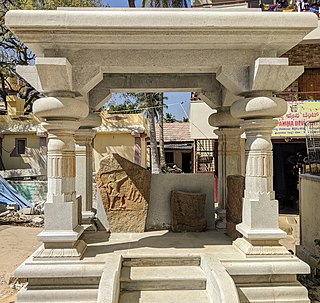 W
WThe Hebbal-Kittayya 750CE Inscription is one of the oldest known Kannada language inscriptions in Kannada script and Bangalore's oldest inscription. The inscription was discovered on 1 May 2018 in Hebbal. The inscription is on a Ooralivu Veeragallu in honour of Hebbal native Kittayya. Ooralivu veeragallu’s are memorial stones erected in honour of a person martyred defending an attack on his or her town.
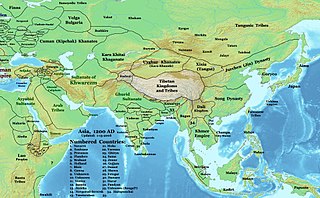 W
WHoysala literature is the large body of literature in the Kannada and Sanskrit languages produced by the Hoysala Empire (1025–1343) in what is now southern India. The empire was established by Nripa Kama II, came into political prominence during the rule of King Vishnuvardhana (1108–1152), and declined gradually after its defeat by the Khalji dynasty invaders in 1311.
 W
WThe Kadamba script is the first writing system devised specifically for writing Kannada and Telugu. It is a descendant of the Brahmi script, an abugida visually close to the Kalinga alphabet. The Kadamba script is also known as Pre-Old-Kannada script. This script later became popular in what is today the state of Goa and was used to write Kannada and Sanskrit.
 W
WThe Kannada language has come a long way in the computing field starting from initial software related to desktop publishing to portals and internet applications in the current age. Kannada is the official language of the state of Karnataka in India whose capital city of Bangalore is known as the Silicon Valley of India. Kannada also entered the Wikipedia world when Kannada Wikipedia was started in September 2004.
 W
WKannada Saahithya Parishath is an Indian non-profit organisation that promotes the Kannada language and its literature. Its headquarter is in the city of Bengaluru in the state of Karnataka, India. It strives to promote Kannada language through publishing books, organising literary seminars and promoting research projects. It also organises an annual conference on Kannada literature called Kannada Sahithya Sammelana. The current president of the parishat is Manu Baligar.
 W
WKannada Sahitya Sammelana is the premier gathering of writers, poets and kannadigas. It is held with the aim of preserving and developing Kannada language, its literature, arts, culture and music. It was started in 1915 by H. V. Nanjundaiah and held at Bangalore for the first time. It used to be inaugurated by prominent writers and poets from 1915 to 1948. Since then it has been inaugurated by the Chief Minister of Karnataka. The Kannada Sahitya Parishat is responsible for holding the gathering.
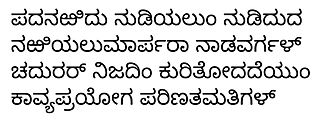 W
WKavirajamarga is the earliest available work on rhetoric, poetics and grammar in the Kannada language. It was inspired by or written in part by the famous Rashtrakuta King Amoghavarsha I, and some historians claim it is based partly on the Sanskrit text Kavyadarsha. Some historians believe Kavirajamarga may have been co-authored by a poet in the king's court, the Kannada language theorist Sri Vijaya.
 W
WMallammana Pavaada is a 1969 Kannada film, directed by Puttanna Kanagal.
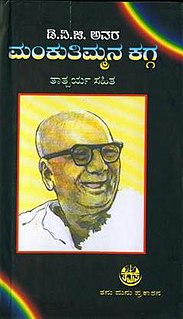 W
WMankuthimmana Kagga, written by Dr. D. V. Gundappa and published in 1943, is one of the best known of the major literary works in Kannada. It is widely regarded as a masterpiece of Kannada literature and is referred to as the Bhagavad Gita in Kannada. The title of the work can be translated as "Dull Thimma's Rigmarole". Kagga is a collection of 945 poems, each being four lines in length. Some of these poems are written in old Kannada. Kagga poems are profound as well as poetic. Most of them can be sung. Though the author calls it an 'a foggy fools farrago', it is a book giving expression to a noble personality's rich experiences. The poet politely that if the word Mankuthimma is crude and below standard it can be substituted by either Venka or Kanka or Shankararya as they please.
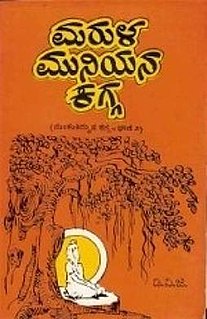 W
WMarula Muniyana Kagga is practically the extension of Mankuthimmana Kagga. These are the stray poems of Devanahalli Venkataramanaiah Gundappa, referred to as DVG, which have been collected together and published after his death. We can find in these poems the expression of fine thoughts of a person who had immense interest in the affairs of divinity. Written by an amateur person each poem contains ripened wisdom of a great scholar. Though the poet claims that Marula Muniya is the brother of Mankuthimma, one could realize before long that Muniya is none other than Mankuthimma himself. It is no wonder if DVG himself must have felt the development of this kind of writing.
 W
WMysore literature in Kannada is a body of literature composed in the Kannada language in the historical Kingdom of Mysore in Southern India and written in the Kannada script. The writings date from the Kingdom of Mysore, which existed from around 1600 CE until the establishment of modern India in 1947. Many of the works of this literature written on religious themes are labeled Veerashaiva or Vaishnava in acknowledgment of the two faiths that gave form to the literature and fostered it until the advent of the modern era. Despite a gradual decline in the popularity of Jainism, authors devoted to the faith produced some works of merit. Secular themes dealing with a wide range of subjects were also written on. Kannada literature flourished for a short while in the court of the neighbouring kingdom of the Nayakas of Keladi whose territory was annexed by Mysore in 1763.
 W
WNarahari Tirtha was a Dvaita philosopher, scholar, statesman and one of the disciples of Madhvacharya. He is considered to be the progenitor of the Haridasa movement along with Sripadaraja. Though only two of his scholarly works are extant, they are characterised by their verbosity and lack of digressions. A few songs of his survive under the nom de plume Raghukulatilaka. As a minister of considerable influence to the Eastern Ganga rulers and later as the pontiff of Madhvacharya mutt, Narahari converted the Simhachalam temple into an educational establishment of renown and a religious centre for Vaishnavism.
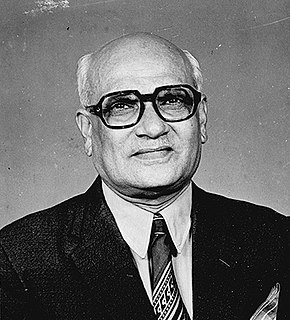 W
WBalagere Narasimhamurthy Sundara Rao or Ba. Na. Sundararao,, who wrote poetry under the pen name Vanavihari, was known by his Kannada initials as Ba.Na.Sum.. Banasum was active in Kannada literary circles from the 1950s until his demise in 1986, and is well known as an author, historian, and journalist.
 W
WRashtrakuta literature is the body of work created during the rule of the Rastrakutas of Manyakheta, a dynasty that ruled the southern and central parts of the Deccan, India between the 8th and 10th centuries. The period of their rule was an important time in the history of South Indian literature in general and Kannada literature in particular. This era was practically the end of classical Prakrit and Sanskrit writings when a whole wealth of topics were available to be written in Kannada. Some of Kannada's most famous poets graced the courts of the Rashtrakuta kings. Court poets and royalty created eminent works in Kannada and Sanskrit, that spanned such literary forms as prose, poetry, rhetoric, epics and grammar. Famous scholars even wrote on secular subjects such as mathematics. Rashtrakuta inscriptions were also written in expressive and poetic Kannada and Sanskrit, rather than plain documentary prose.
 W
WSharapanjara is a 1971 Indian Kannada language film directed by Puttanna Kanagal, based on a novel by Triveni of the same name, and starring Kalpana and Gangadhar in lead roles. This film is considered one of the best Kannada movies ever made. Triveni's novel was richly visual and Puttanna not only stayed faithful to the novel on screen but also retained most of the novel's dialogues and credited Triveni for them.
 W
WShunyasampadane is an anthology of poems in the Kannada language that includes the vachanas and dialogues of several Lingayat saints. It is an important part of the holy scriptures of lingayats.The word Shunyasampadane can be roughly translated as "the acquisition of nothing" in which Shunya translates to "nothingness", "void" or "empty". The more precise translation is 'the Graduated Attainment of the Divine Void'. It is part of the important concepts associated with enlightenment in the Indian traditions.
 W
WSri Ramayana Darshana is the most popular work and the magnum opus by Kuvempu in Kannada based on the Hindu epic Ramayana. It earned him many distinctions including the Sahitya Akademi Award and the Jnanapeeth award in 1967.
 W
WThe Sritattvanidhi is a treatise written in the 19th century in Karnataka on the iconography and iconometry of divine figures in South India. One of its sections includes instructions for, and illustrations of, 122 hatha yoga postures.
 W
WTabarana Kathe is a 1987 Indian Kannada-language film released directed by Girish Kasaravalli. It was based on a short story of the same name by Poornachandra Tejaswi.
 W
WTabbaliyu Neenade Magane Godhuli is a 1977 Indian drama film co-directed by Girish Karnad and B. V. Karanth, starring Kulbhushan Kharbanda, Om Puri and Naseeruddin Shah.
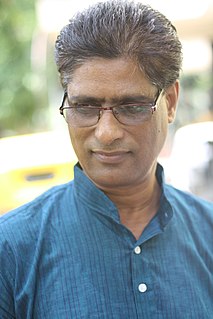 W
WRahamat Tarikere is a Kannada writer, critic and teacher. He is well known for his sharp insights and his critical view on culture. He is one noted writers of the new generation of writers in Kannada. Currently he is a Professor in Kannada University at Hampi.
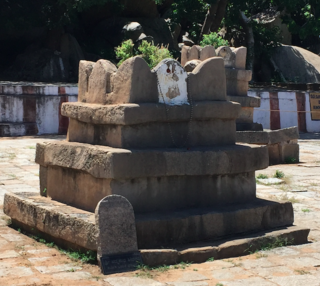 W
WPadmanabha Tirtha was a Dvaita philosopher, scholar and the disciple of Madhvacharya. Ascending the pontifical seat after Madhva, he served as the primary commentator of his works and in doing so, significantly elucidated Madhva's terse and laconic style of writing. His pioneering efforts in expanding upon the Dvaita texts to uncover the underlying metaphysical intricacies was taken forward by the 14th Century philosopher, Jayatirtha. Padmanabha is also credited with disseminating the philosophy of Dvaita outside the Tulunadu.
 W
WVachana sahitya is a form of rhythmic writing in Kannada that evolved in the 11th century CE and flourished in the 12th century, as a part of the Sharana movement. Madara Chennaiah an 11th-century cobbler-saint who lived during the reign of the Western Chalukyas and who is regarded by some scholars as the "father of Vachana poetry." The word "vachanas" literally means "(that which is) said". These are readily intelligible prose texts.
 W
WSri Vadiraja Tirtharu was a Dvaita philosopher, poet and mystic. A polymath of his time, he authored many works, often polemical, on Madhva theology and metaphysics. Additionally, he composed numerous poems and as the pontiff of Sodhe Mutt, renovated the temple complex at Udupi and established the Paryaya system of worship. He is also credited with enriching the Kannada literature of the time by translating Madhva's works to Kannada, giving impetus and contributing to the Haridasa movement. His works are characterised by their poetic flourishes, incisive wit and humour.
 W
WVijayanagara literature was produced in the Vijayanagara Empire during a golden age of literature in South India in general. The rulers patronised Kannada, Telugu, Sanskrit and Tamil scholars who wrote in the Jain, Virashaiva and Vaishnava traditions. The period produced hundreds of works on all aspects of Indian culture, religion, biographies, Prabhandas (stories), music, grammar, poetics and medicine. An attempt is made in this section to list the various poets and saints and their most famous works.
 W
WVijayanagara literature in Kannada is the body of literature composed in the Kannada language of South India during the ascendancy of the Vijayanagara Empire which lasted from the 14th through the 16th century. The Vijayanagara empire was established in 1336 by Harihara I and his brother Bukka Raya I. Although it lasted until 1664, its power declined after a major military defeat by the Shahi Sultanates in the battle of Talikota in 1565. The empire is named after its capital city Vijayanagara, whose ruins surround modern Hampi, now a World Heritage Site in Karnataka.
 W
WA large body of Western Chalukya literature in the Kannada language was produced during the reign of the Western Chalukya Empire in what is now southern India. This dynasty, which ruled most of the western Deccan in South India is sometimes called the Kalyani Chalukya Dynasty after its royal capital at Kalyani and sometimes called the Later Chalukya Dynasty for its theoretical relationship to the 6th-century Chalukya dynasty of Badami. For a brief period (1162–1183), the Kalachuris of Kalyani, a dynasty of kings who had earlier migrated to the Karnataka region from central India and served as vassals for several generations, exploited the growing weakness of their overlords and annexed the Kalyani. Around 1183, the last Chalukya scion, Someshvara IV, overthrew the Kalachuris to regain control of the royal city. But his efforts were in vain, as other prominent Chalukya vassals in the Deccan, the Hoysalas, the Kakatiyas and the Seunas destroyed the remnants of the Chalukya power.
 W
WWestern Ganga literature refers to a body of writings created during the rule of the Western Ganga Dynasty, a dynasty that ruled the region historically known as Gangavadi between the 4th and 11th centuries. The period of their rule was an important time in the history of South Indian literature in general and Kannada literature in particular, though many of the writings are deemed extinct. Some of the most famous poets of Kannada language graced the courts of the Ganga kings. Court poets and royalty created eminent works in Kannada language and Sanskrit language that spanned such literary forms as prose, poetry, Hindu epics, Jain Tirthankaras (saints) and elephant management.